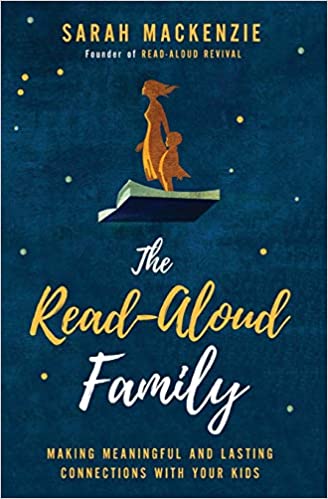Most parents know that it’s important for their children to learn to read and to be exposed to good literature. Sarah Mackenzie takes it a step further in The Read-Aloud Family, by emphasizing the importance of reading aloud, even with older children, and by providing us with up-to-date lists of recommended books.
This book is broader in scope than just the promotion of reading aloud to children so they learn to appreciate good books. Mackenzie wants parents to view reading good books as opportunities for children to develop a capacity for delight and wonder. Good books also open the world to children and help them become compassionate, caring human beings. To that end, Mackenzie helps us learn to identify worthy books, commenting that, “A book should fill us with hope, even in the midst of bone-rattling thrill or heart-wrenching sorrow” (p. 143).
Mackenzie conveys ideas such as these using her own storytelling skills accompanied by friendly and practical advice. Some of the chapters read as if they originated as blog articles.
There is no perfect structure or plan for turning your family into a “read-aloud family.” And trying to make it happen in a busy household is likely to be an unruly process. However, Mackenzie tells us that it is important to be intentional and set ourselves up for success as much as we can. She has an entire chapter about this! For example, one of her “success” techniques is to have a read-aloud shelf (or basket or drawer, etc.) that includes hands-on stuff that you know your children will work with while you read aloud. This might include drawing supplies, craft materials, paint, scissors, etc. Busying their hands will help to keep them from wandering off, wrestling with each other, or finding other ways to occupy their bodies while you try to read.
Parents sometimes feel guilty when they don’t have enough time to read aloud or don’t have adequate reading skills to make it enjoyable for their children. Mackenzie recommends audiobooks with no apologies or implications that they are a less-optimal choice. She mentions them as a much-better-than-screen-time option for long car rides, and some of her annotated recommendations actually tell us to listen to particular books rather than reading them.
It's great to have discussions with our children about both the books they read on their own and the books we read aloud together. Mackenzie prepares us for discussions by offering "five keys" for having conversations about books. For instance, the fourth key she suggests is “Plant seeds and step aside.” This means that even when you have a conversation about a book, you should leave space for ideas to sprout and grow in a child’s mind rather than discuss every last nugget you can find. As Mackenzie says, “Let the book work its magic on the soul of your child” (pp. 162-163).
Clearly, stepping aside doesn't mean skipping conversations, and we want those conversations to be meaningful. While we can ask our children questions such as, “Did you like the book?”, that type of question can lead to a dead end when our child simply answers yes or no. Instead, Mackenzie presents ten questions that are more compelling—that are likely to stimulate more open-ended conversations. For example, the second of these questions is “Should he or she have done that?” (p. 168).
Mackenzie tells us that “Booklists are your training wheels. They are invaluable to the parent who is learning how to put good books into the hands of her children—to spur a love of reading and fill a home with the best books that can be found” (p. 143). Since many of us appreciate the help of "training wheels," she includes four chapters with lists of books she recommends for four levels, ages 0-3, ages 4-7, ages 8-12, and the teen years. Each recommendation is accompanied by a paragraph that tells why Mackenzie selected the book, something about the story, something about the style of writing, key ideas that crop up, or other information that might tempt you to check it out. Recommendations of picture books dominate the younger levels, and there are still some picture books recommended for older children, such as Castle by David Macaulay.
Most recommendations are fiction, but there are a few non-fiction titles, such as Castle. The recommended novels are a mixture of modern classics like Little House in the Big Woods and newer books. Recommendations of newer books are especially helpful because publishers today so often cater to the latest cultural causes, and it’s easy to be blindsided by topics that pop up in books—topics you’d rather not expose your children to yet. Mackenzie adds a recommendation for her favorite Bible (for older children) or collections of Bible stories (for younger children) to read aloud to each age group. This and a few other instances alert us that Mackenzie's primary audience is likely to be Christian, but The Read-Aloud Family is still useful for all families.
You can use Mackenzie’s lists then—as she suggests—start branching out on your own as you develop skills for sorting through books yourself. Mackenzie provides her readers with a three-question test that can be used for selecting picture books—it takes just a few minutes to answer the three questions if you either have access to the physical book or you can access a sample online.
The Read-Aloud Family will almost certainly help you expand your children’s world with good books. And while reading helps children develop academic skills, there is so much more that takes place when a child is introduced to a worthy book.









